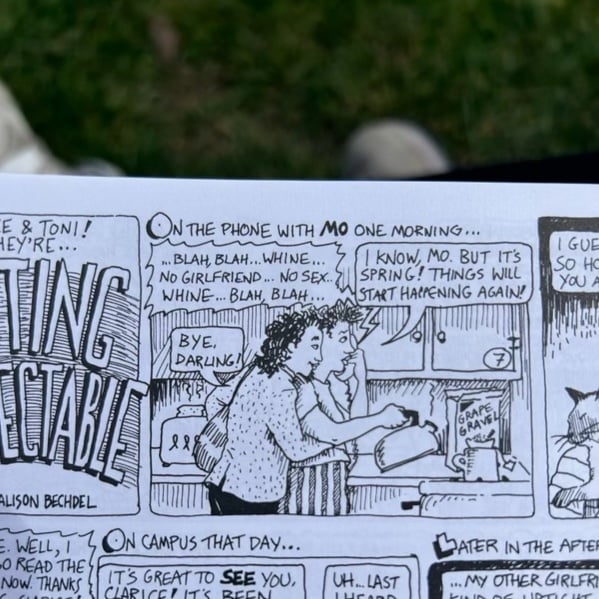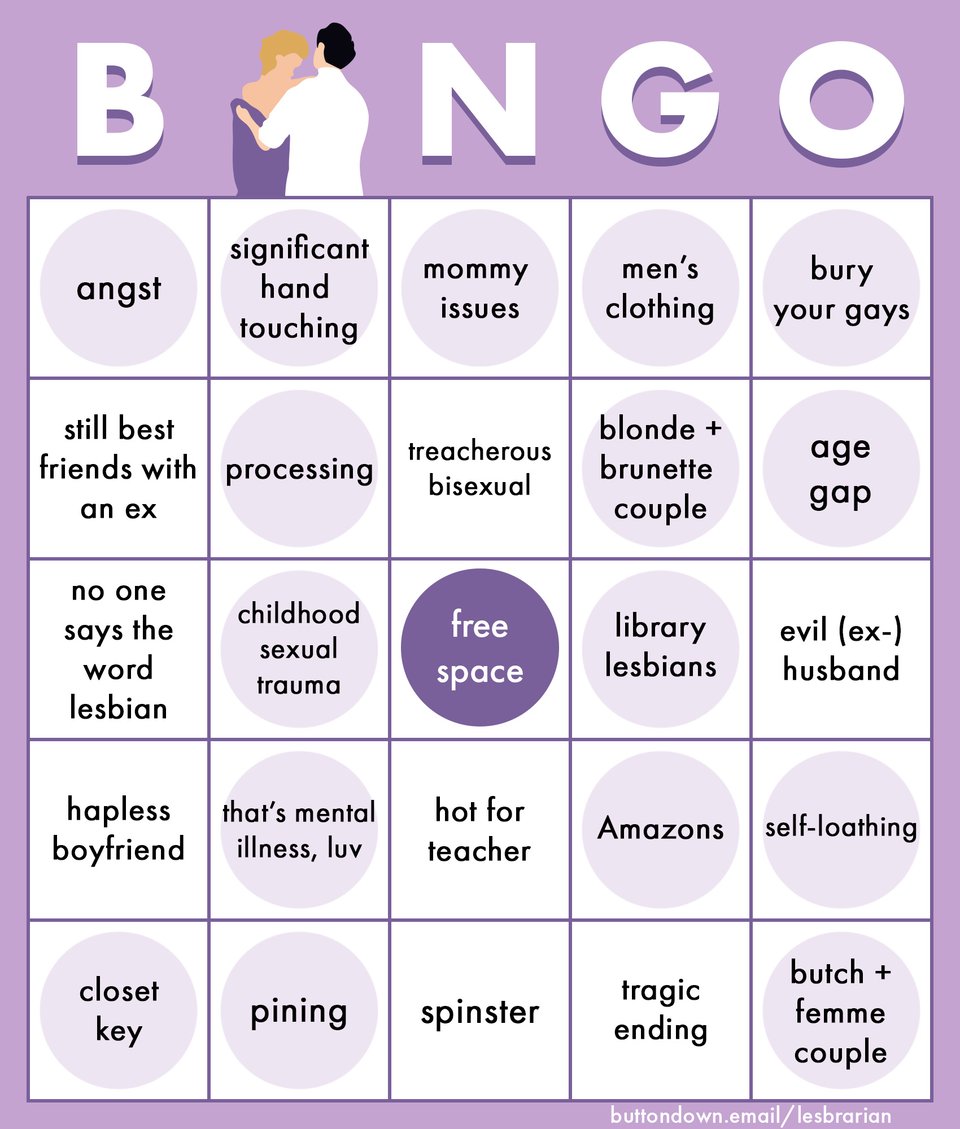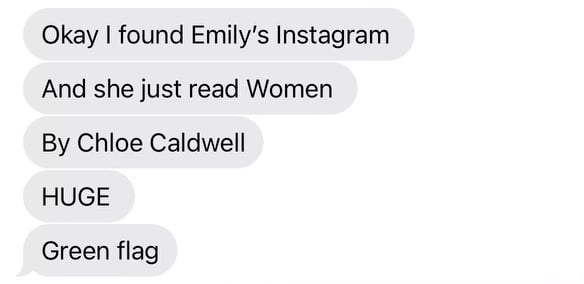A Year of Reading Lesbianly

2024 was my year of reading lesbianly. Not only did I write about eight books for this newsletter (pitiful, I hope to cover more next year), I read 34 books that could be broadly defined as having lesbian content. Rather than breaking them down by genre (mostly novels) or decade (mostly 2020s, with a good smattering from the 50s, 80s, 90s, and 2010s), I’ve assigned superlatives to the eight books I wrote about this year, plus a few more that I felt merited a mention here.
Most frequently recommended: The Price of Salt by Claire Morgan/Patricia Highsmith (1952)
For much of this year, my Hinge profile mentioned that I wrote a newsletter about old lesbian books, which led to a number of conversations about lesbian books on the app. The book I recommended most often in these conversations, as well as those I had in person, is also the one that inspired this newsletter; a gorgeously written Bildungsroman in the garb of a midcentury crime novel.
Most complained about: People in Trouble by Sarah Schulman (1990)
This biting social novel about an affair between a young activist and an older, married artist set during the early years of the AIDS epidemic was my favorite book of the year, but you can only read it if you’re willing to order the UK edition or search through used bookstores run by people with good taste. Re-publish this book in the United States, you cowards!!!
Most surprising: Women’s Barracks by Tereska Torrès (1950)
I expected to find this novel, based on the author’s experiences of serving in the Corps of French Female Volunteers during World War II, corny and dated. While it was both of those things—the end is so saccharine I completely ignored it in my newsletter and the ideas around lesbian sexuality were decades old even in the 50s—it also had a lively cast of characters and a fascinating publication history, both of which made it a surprisingly compelling read.
Most surprisingly lesbian: The Color Purple by Alice Walker (1982)
Nine times out of ten when I told a non-queer person about a lesbian book I had read this year, they hadn’t heard of the book at all and were therefore unsurprised at its lesbian-ness. The rest of the time, I told them I was reading The Color Purple and they were shocked to learn that the book was in any way queer. While it’s possible some of these people haven’t read it, I suspect many of them have just allowed Stephen Spielberg’s movie adaptation to color their memory of the book, which includes several lesbian sex scenes that don’t make it to screen. Steve, you’re on my list for that one.
Characters most in need of the lesbian masterdoc: Mitch and Leda from Spring Fire by Vin Packer/Marijane Meaker (1952)
These two co-eds spent as much time applying and re-applying various sexual labels to themselves as they did making out. That doesn’t make for a particularly exciting novel, but it did give me an opportunity to go long on Library of Congress Subject Headings and the DSM.
Most embarrassing character to relate to: Mo from The Essential Dykes to Watch Out For by Alison Bechdel (2008)

Apologies to anyone who had the misfortune to talk to me about my love life this year.
Most brain re-wiring: How to Suppress Women's Writing by Joanna Russ (1983)
I never quite figured out how to write about this book, which details the way women’s writing has been belittled, dismissed, and pushed to the margins of the Western canon. Published by an author best known for her science fiction—a genre I don’t particularly enjoy—I found it bitingly funny, as brainy as it is accessible, and surprisingly, depressingly current.
Most horny: I Await the Devil’s Coming by Mary MacLane (1902)
Mary MacLane isn’t an explicit or sexy writer by modern standards, there are certainly no sex scenes in I Await the Devil’s Coming. She is, however, an exceptionally horny writer, devoting pages to her intense, “masculine” crush on her former teacher and longing for the devil to kiss and embrace her… ok Lily-Rose Depp.
Most trope-y: Stone Butch Blues by Leslie Feinberg

I also considered giving this the superlative “most disappointing” or “book that made my therapist most worried about me,” but in the end, I couldn’t ignore that Stone Butch Blues got lesbian classic cliché bingo not once, not twice, but four times. An inspiring performance unlikely to be repeated.
Best book to read on vacation: Fair Play by Tove Jansson

While I doubt Tove Jansson had beach reading in mind when she wrote this lovely, subtle novella about two artists living in separate apartments in the same building, the short chapters are ideal for sneaking in between mini-naps and dips in the ocean. Much like her more obviously vacation-y (and much less lesbian) novella The Summer Book, this is a book that rewards quiet contemplation between pages, so I particularly enjoyed reading it on a lazy day during summer trip to Block Island.
Best book to give to the tween in your life who makes you go, “is she…?”: How it All Ends by Emma Hunsinger

I was completely charmed by this book about an anxiety ridden 13 year-old whose early entry into high school sends her into a tailspin, made worse by some confusing feelings towards a new classmate. When I picked this up at work, I didn’t realize the main character was going to be queer, so imagine my surprise and delight when it turned out to have fantastic illustrations, snappy writing, and lesbian content.
Best post-breakup read: After Delores by Sarah Schulman (1988)
I picked up this book after the end of a sort-of relationship this summer and I’ve gotta say, reading about a woman who responded to her breakup by drinking constantly, showering never, acquiring a gun, and becoming obsessed with a murdered go-go dancer made me feel like I was handling things pretty well. When my library system asked for submissions for a year-end staff pick list, I didn’t hesitate to submit this fast-paced neo-noir set in the gay underground of 1980s Manhattan, if only because we don’t have a copy of People in Trouble.
Best book to lend to your lover: Women by Chloé Caldwell

Partially because doing so is alluded to in the introduction, partially because I was sent the above screenshot by the woman I was seeing in October, loaned Women to her in November, and was her girlfriend by December. I’m not sure this book about a disastrous first gay love affair sealed the deal, but I don’t think it hurt.
Best introduction: Carmen Maria Machado (2019) on Carmilla by Sheridan Le Fanu (1872)
One of the joys of reading older novels, particularly “rediscovered classics,” is having the opportunity to read a book alongside a smart person’s take on what makes it great. I enjoyed a surprising number of introductions this year—the wonderful Ali Smith on Fair Play, Katie Heaney on Women—but none was better than Carmen Maria Machado’s on Carmilla. Not only does it create a fictional Gothic-style frame narrative for the text, something that got the edition a lot of press when it was first released in 2019, it also articulates a way of reading queer classics that I find very compelling. She writes,
“The act of interacting with text, that is to say, of reading, is that of inserting one's self into what is static and unchanging so that it might pump with fresh blood. Having read this introduction, I hope you will enter into Carmilla thusly, using your fingertips and mouth and mind to locate the lacunae where LeFanu excised pieces of Veronika's account, the hallways haunted by the specters of truth and phantoms of passion. See if you cannot perceive what exists below: the erotic relationship of two high-strung and lonely young women. The shared metropolis of their dreaming. An aborted picnic in the ruins.”
It really doesn’t get much better than that.
More soon, I promise.
Your local lesbrarian,
Emily